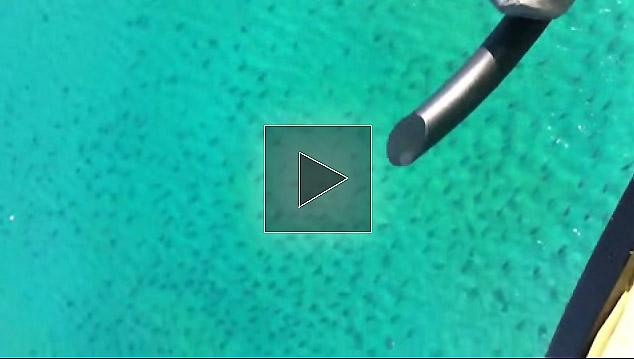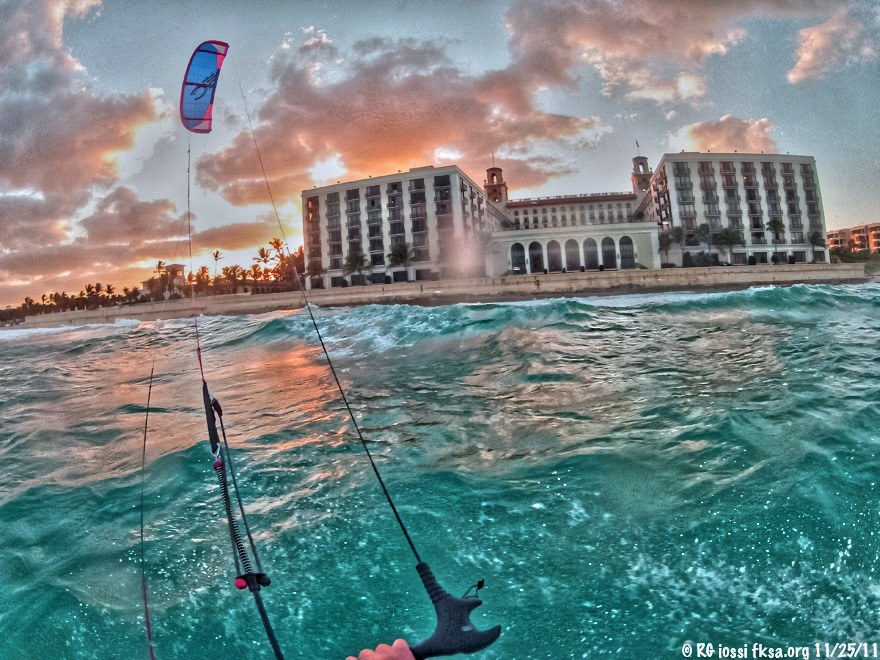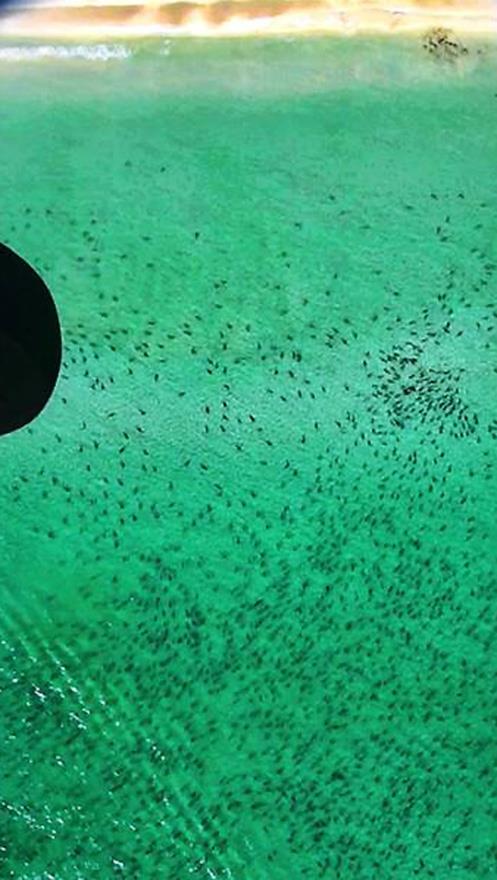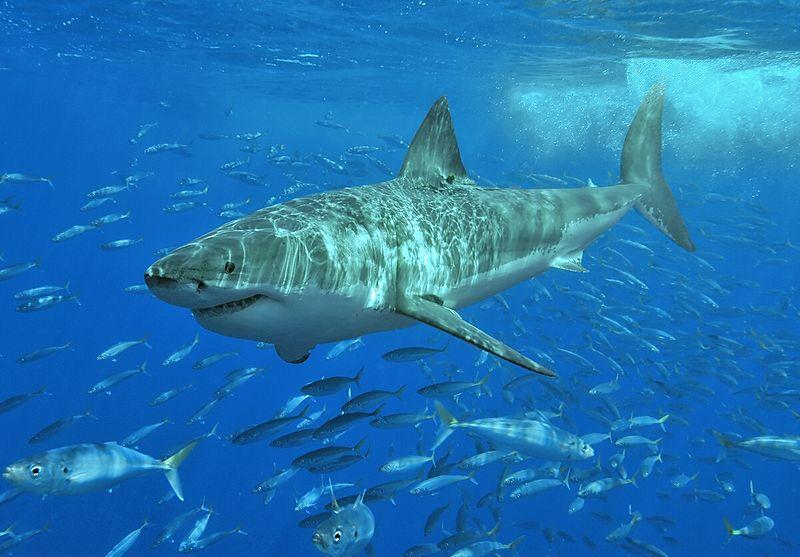
 |
|
|
|
#1
|
||||
|
||||
|
The migration is on and I there seems to be some larger sharks mixed in with the blacktips in the video shot off Palm Beach. Perhaps bulls or tigers. Steve Schafer suffered a fatal attack almost a year ago just north of this area.
"Thousands of sharks spotted off Palm Beach Posted: 01/31/2011 Last Updated: 48 minutes ago By: Mollie Reynolds PALM BEACH, Fla. - Pilot Steve Irwin has quite a fish tale, and he wasn't even fishing. Irwin is a pilot with "Island Marine Services" based in Fort Pierce. He said he was flying about 100 yards off of Palm Beach, at 80 mph, when he spotted thousands of sharks. He pulled out his iPhone 4 and began taking pictures. He recorded the spectacular sight and wanted to share it. This is the time of year when sharks migrate and head for warmer waters. They also typically swim close to the shore while chasing after bait fish." http://www.wptv.com/dpp/news/local_n...off-palm-beach There is also a video at:   http://www.sun-sentinel.com/news/pal...,6985985.photo .
__________________
FKA, Inc. transcribed by: Rick Iossi Last edited by ricki; 01-25-2013 at 01:30 PM. |
|
#2
|
||||
|
||||
|
Toby had this question on kiteforum:
Quote:
Quote:
__________________
FKA, Inc. transcribed by: Rick Iossi |
|
#3
|
||||
|
||||
|
I debated about throwing this up but figured why not? I would take a good look at the clip. It is best at 720p with a popped out screen for better detail. This was likely shot in the first few months of 2010 during the normal winter spinner migration. The location was in Delray Beach, Florida, 65 miles south of Hutchenson Island where Steve Schafer was attacked. The migration may go for a couple of months on and off along the SE coast of South Florida. Although not identified in a lot of fatal attacks, spinners and blacktips account for the majority of unprovoked shark attacks in Florida.* They may often be "hit and run" attacks, take a bite, find it isn't fish and move on.
I originally thought it was more like "kiter chases dozens of sharks." Taking a closer look at the clip, I see this isn't entirely accurate. Early on the sharks ignore the kiter, later in the clip you will see quite a few turn and accelerate towards him. It is a good thing he is riding a strapless surfboard, no one ever slides off one of those by accident?! Even with straps there are lots of things that will send us into the water at times. Just because you go into the water doesn't mean a blacktop will hit you. Then again, it does happen that way at times. If you splash going in or are in for an extended period the odds of a problem go up. There are also the larger more aggressive sharks riding herd on the smaller tasty blacktops to think about. There were a few larger shadows in the clip. We had a guy trying to teach himself how to kite in Hutchinson Island years back with bait kicking up and during the migration. He as attacked pretty intensively but survived, recovered and elected to move inland far from the ocean after. Like I said, I rode with these guys for four days once, thick like this too much of the time. Unlike in this video shot from the kite, the only time I noticed them making a run on me was around feeding time, sunset. Their dorsal fins were on the surface making detection pretty easy. I suspect there may have been a lot of other times that I may have missed. Thinking things over, I think I will pass on future opportunities. Opportunities lost in this case might be a good thing. * http://www.flmnh.ufl.edu/fish/sharks...iesattacks.htm
__________________
FKA, Inc. transcribed by: Rick Iossi Last edited by ricki; 01-25-2013 at 01:31 PM. |
|
#4
|
||||
|
||||
|
The northbound blacktop shark migration is back. Thousands were seen off the Breakers Hotel in West Palm Beach yesterday from the air.
This may continued on and off for several weeks or more.  A sunset session shot of the Breakers Hotel from last November 2011. Steve Schafer was likely attacked off Hutchinson Island by a larger, more aggressive bull or tiger shark feeding on this migration in February 2010. .
__________________
FKA, Inc. transcribed by: Rick Iossi Last edited by ricki; 01-25-2013 at 01:31 PM. |
|
#5
|
||||
|
||||
|
The shark migration is a regular thing, first they go south in the fall and then they head back north. Often they are seen moving north in March but a mass sighting was made a few days ago south of Lake Worth Inlet.
 "( Sun Sentinel / January 17, 2013 ) Migrating blacktip sharks photographed south of Palm Beach Inlet by Stephen Kajiura, associate professor of biology at Florida Atlantic University, who is studying shark migration patterns. Kajiura's study involves flights every two weeks along the Palm Beach County coast to videotape the sharks." http://www.sun-sentinel.com/news/pal...,5572881.photo A aerial video clip of the 2010 migration off Singer Island Kiters will remember that Stephen Schaffer was lost in 2010 during the annual migration as a result of a shark attack off south Hutchinson Island while kitesurfing. It is thought that larger sharks such as bull or tiger sharks preying on the smaller blacktop sharks of the migration may have attacked Steve. Spinner and similar blacktop sharks have been given credit for attacks on in the past. "Blacktip sharks are responsible for roughly 16% of the attacks that occur in Florida waters, often striking surfers." http://www.flmnh.ufl.edu/fish/galler...ktipshark.html http://www.flmnh.ufl.edu/fish/galler...nnershark.html So, it may be prudent to assume that spinners and the larger, more aggressive trailing sharks may be present off parts of SE Florida for the foreseeable future. There are holes in the migration but it may be difficult to know whether a hole is passing through your area or not. The thing about sharks is that they can bite and statistically will do just that where humans are involved through time particularly in opportunistic circumstances. It is worth keeping that in mind and acting accordingly. .
__________________
FKA, Inc. transcribed by: Rick Iossi Last edited by ricki; 01-25-2013 at 01:32 PM. |
|
#6
|
||||
|
||||
|
The Sunsentinel carried a full article on the shark migration, see below. There is also an informative video clip there worth watching.
"Thousands of sharks share South Florida's surf By David Fleshler, Sun Sentinel 2:46 p.m. EST, January 18, 2013 The sharks stream in the thousands up South Florida's coast, a sight that might terrify the people playing in the surf less than a football field away. From a Cessna 172 flying slowly along the beach, Stephen Kajiura videotapes this procession of oceanic predators as they engage in their annual migration from North Carolina. Kajiura, an associate professor of biology at Florida Atlantic University, is conducting the first systematic study of the migrations of blacktip sharks, a pattern that has led lifeguards to close beaches and may be linked to increases in shark bites. "Every year we see the same thing, large numbers of sharks off South Florida," he said. "We've got this really strong, seasonal influx of sharks. They spend the winter here and go up north again. We've known about the phenomenon for years, but no one's ever studied it." The migrations run from roughly Cape Hatteras, N.C., to Broward County, or possibly northern Miami-Dade County, Kajiura said. The sharks start arriving in December, with numbers peaking in January and February before tapering off. By April, very few are left in South Florida. They're following their prey, largely schools of mullet. Since February of 2011, Kajiura or a friend has piloted the Cessna every two weeks on a route from Boca Raton to Jupiter Inlet with a video camera mounted on the plane. Back at the office, he analyzes the tapes, counting the sharks and noting their locations. The numbers are shocking. On the strip of ocean he studies, running from shore to about two football fields out, he has counted 15,000 sharks on a single trip." Continued at: http://www.sun-sentinel.com/news/pal...,3383821.story
__________________
FKA, Inc. transcribed by: Rick Iossi |
|
#7
|
||||
|
||||
|
I communicated with graduate student Shari Tellman working under Professor Stephen Kajiura on the areal shark video survey. She told me that they have been performing a study of the blacktip shark population off Palm Beach County between February 2011 and March 2013. They hope to acquire baseline abundance data for comparison to findings in future studies to monitor environmental effects such as climate change on the distribution and relative numbers of this important apex predator.
She indicated that the blacktips, very similar to appearance to spinner sharks but still a different species, migrate south into Broward and Miami-Dade Counties in the fall. The sharks remain offshore in deeper water in the fall and early winter. This may account for the lower quantities of sightings spread out in deeper, sometimes turbid water. Then in the spring they migrate northward to Georgia and the Carolinas to breed. In their survey they have noticed sharks to be prevalent off Palm Beach county in late January into early March. So, the appearance of masses of sharks south of Lake Worth Inlet at this time of year isn't unusual.  A figure provided by Ms. Tellman showing the narrow shelf off Palm Beach County compared to points south. Ms. Tellman indicated that the sharks follow and prey upon large schools of baitfish such as mullet which in large measure explains their distribution at various times of the year. She indicated that the narrow continental shelf off Palm Beach County serves to concentrate larger masses of sharks closer to shore. Adding in the better water visibility and influence of the Gulfstream under certain conditions, the sharks are even more noticeable than they might be spread out in more turbid waters in the two southern counties. I had wondered about the appearance, disappearance and eventual reappearance of the shark aggregations off beaches in Palm Beach County. Specifically I was curious about significant factors influencing shark local distribution during the migration. She responded the nearshore distribution of the blacktips is patchy and speculated it may be attributable to food availability and sea state. In heavier seas the sharks may move to deeper water to where they may be less noticeable. Where there is an abundance of baitfish the sharks may be quite concentrated. I asked if they had impressions about the relative abundance of larger sharks such as bulls and tigers escorting and feeding upon the blacktip migration. She stated that their video imaging doesn't allow for identification of various shark species but that larger individuals were noted which might be bull and tiger sharks. I want to thank Shari Tellman for taking the time to provide detailed responses to my questions and wish them all success with their study and eventual publication. What follows are some personal observations. So, the migration is on, have a care out there. Fatal shark attacks on kiters worldwide are infrequent. Certainly they are far less common that squall/wind related fatal kiting accidents. Then again, what percentage of the global kiter population ride in shark migrations for extended periods of time such as may be the case off here and now. By comparison, shark attacks on surfers are far more common particularly in Florida. I understand from other sources that our "taste" isn't to most shark's liking, not "fishy" enough. Blacktips may strike and then leave particularly in conditions of poorer visibility. Usually the injuries have been fairly minor with the smaller shark size and fleeting presence. Apparently we aren't on the favorites list with bulls or tigers either. The problem is a larger shark/bite radius the more damage that can be done. The location of the bite is also particularly relevant. Sharks may strike your thigh area to apparently disable locomotion, putting your femoral artery at risk as has happened in a number of severe attacks in various parts of the world. Multiple bites further compound the injury if such occurs. Remember the sharks chasing the kiter after transitions. Also, if you bust a landing near a shark or slide off your strapless board it may strike out of impulse then move on or it may just ignore you entirely. It is fair to say, the odds of a negative encounter increase kiting during the migration, in areas with visible sharks, in areas with jumping bait and feeding birds and in my personal experience, near sunset. How much do they increase, who knows? For my part if there are visible shark signs of the migration, I will probably not go kiting at that location, at that time. It doesn't remove risk but it may serve to reduce it. It is worth thinking over.  Blacktip sharks http://en.wikipedia.org/wiki/File:C._limbatus.JPG .
__________________
FKA, Inc. transcribed by: Rick Iossi Last edited by ricki; 01-25-2013 at 01:14 PM. |
|
#8
|
||||
|
||||
 NPR interviewed local shark researcher, Dr. Stephen M. Kajiura of FAU. " Sharks, Sharks, Everywhere By Luis Hernandez • 14 hours ago There are literally tens of thousands of sharks that come down and spend the winter right off our beaches here in Southeast Florida. Add to that the fact that Florida beaches are very popular for tourists and locals. Those are the ingredients that have made Florida the world's leader in shark attacks. Dr. Stephen M. Kajiura of the Elasmobranch Research Laboratory, Biological Sciences, Florida Atlantic University Blacktip sharks are a medium sized shark. They’re maybe just about six feet long at the most. They are primarily fish eaters, and they will come down, spend the winter down here (South Florida) where the temperature is preferred. And then they'll follow that preferred temperature up the coast in the spring. So they migrate farther north and spend the summers off the Carolinas before coming back here again the next year. Carcharhinus melanopterus: blacktip reef sharks are grey or brown on the dorsal area and white on the ventral. The tips of each of its fins are black with a lighter band lying just below the black Credit https://bioweb.uwlax.edu/bio203/f201...adaptation.htm / Organismal Biology at University of Wisconsin - La Crosse I'd imagine as a researcher that you spend a lot of your time up close with underwater species. Why did you want to get this bird's eye view of blacktip sharks? Well, for many years I would get inquiries from the local media saying that their news helicopters had seen large numbers of the sharks (from above). I told them all it is is a migration that happens every year. No big deal. But when I had the opportunity to do the flying myself and see the animals I said this is really ripe for exploration. And the best way to address this, to cover a large area of the coast, is to do it by airplane and get this bird's eye view. And that's really the best way to count the numbers of sharks and see how many there are and when they're here. And that's what we started back in 2011. And besides getting the count, what else do you learn from that vantage point?" Continued at: http://wlrn.org/post/sharks-sharks-everywhere PLUS link to in-depth radio interview .
__________________
FKA, Inc. transcribed by: Rick Iossi |
 |
|
|